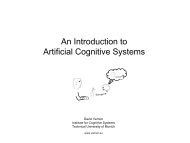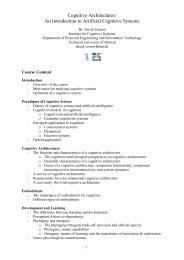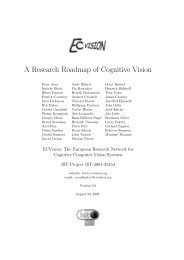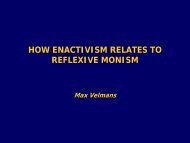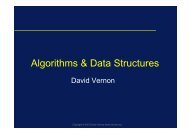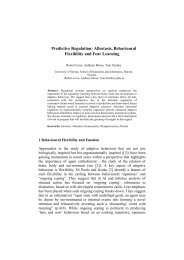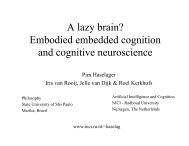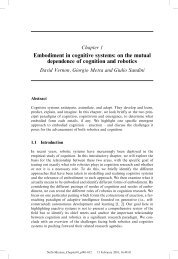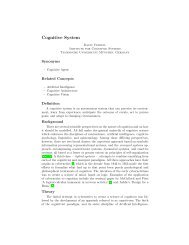Dynamic Field Theory (DFT): Applications in Cognitive Science and ...
Dynamic Field Theory (DFT): Applications in Cognitive Science and ...
Dynamic Field Theory (DFT): Applications in Cognitive Science and ...
Create successful ePaper yourself
Turn your PDF publications into a flip-book with our unique Google optimized e-Paper software.
pulse <strong>and</strong> wave, active transient etc., see [12] for a recent overview) that play an<br />
important role <strong>in</strong> some applications of the dynamic field approach to cognition (see the<br />
examples below).<br />
<strong>Applications</strong> <strong>in</strong> <strong>Cognitive</strong> <strong>Science</strong>: Action, Perception <strong>and</strong> Reason<strong>in</strong>g<br />
The dynamic field approach has been first developed <strong>and</strong> applied <strong>in</strong> the context of<br />
simple sensorimotor decisions ([13], [14], [15]). Timed-movement <strong>in</strong>itiation paradigms<br />
reveal that plans for goal-directed arm or eye movements evolve cont<strong>in</strong>uously <strong>in</strong> time.<br />
Early dur<strong>in</strong>g action preparation an externally forced decision to move reflects the prior<br />
knowledge about the task (e.g., number <strong>and</strong> probability of possible targets) whereas<br />
later <strong>in</strong> time the decision is dom<strong>in</strong>ated by the visual <strong>in</strong>formation specify<strong>in</strong>g the target. In<br />
the <strong>DFT</strong> model [14], a localised activation peak <strong>in</strong> the movement parameter field<br />
evolves <strong>in</strong> time under the <strong>in</strong>fluence of the two <strong>in</strong>puts sources represented by activation<br />
patterns <strong>in</strong> two connected fields. Due to the constant <strong>in</strong>put from the task field, the build<br />
up starts from a pre-activated <strong>in</strong>itial state reflect<strong>in</strong>g prior task knowledge. S<strong>in</strong>ce the<br />
level of pre-activation affects the rate at which the activation peak rises, all classical<br />
effects of task environment on reaction time can be modelled. Moreover, the field<br />
model also accounts for experimental f<strong>in</strong>d<strong>in</strong>gs show<strong>in</strong>g that not only the <strong>in</strong>formational<br />
content (e.g., number <strong>and</strong> probability of choices) but also the metric of the movement<br />
parameter space matters. A simple example is a two choice task <strong>in</strong> which the relative<br />
distance between the possible directions of the movement is systematically varied. A<br />
general experimental f<strong>in</strong>d<strong>in</strong>g is that reaction time decreases with decreas<strong>in</strong>g distance. In<br />
the model, the two-choice sett<strong>in</strong>g lead to a bimodal preshape. For metrically close<br />
directions, however, the two preshape <strong>in</strong>puts start to overlap, result<strong>in</strong>g <strong>in</strong> a higher level<br />
of pre-activation. As a consequence, the buildup of the peak <strong>in</strong> response to a specific<br />
<strong>in</strong>put is faster compared to the case of two movement directions metrically fare from<br />
each other.<br />
It is worth mention<strong>in</strong>g that the dynamic field concepts can be generalized to the<br />
case of multiple movement parameters by <strong>in</strong>troduc<strong>in</strong>g multidimensional activation<br />
fields. A two-dimensional field spanned over movement direction <strong>and</strong> movement<br />
amplitude has been used for <strong>in</strong>stance to expla<strong>in</strong> differences <strong>in</strong> the process of<br />
specification of the two parameters as revealed <strong>in</strong> precu<strong>in</strong>g paradigms [14].<br />
The <strong>DFT</strong> approach to sensorimotor decisions has been extended to address<br />
fundamental questions <strong>in</strong> developmental cognitive science. An excellent example is the<br />
<strong>DFT</strong> model of Piaget’s classic ‘A-not-B’ error [16]. In this task, an <strong>in</strong>fant is faced with<br />
two similar opaque conta<strong>in</strong>ers with lids. The experimenter hides a toy under the lid at<br />
location A <strong>and</strong> the <strong>in</strong>fant is tra<strong>in</strong>ed to reach for the toy. If after several A trials the<br />
object is hidden for the first time at location B <strong>and</strong> a short delay is imposed, younger<br />
<strong>in</strong>fants nevertheless reach toward conta<strong>in</strong>er A. This typical ‘A-not-B’ error is absent <strong>in</strong><br />
older <strong>in</strong>fants. The <strong>DFT</strong> model expla<strong>in</strong>s this change <strong>in</strong> behaviour as a shift from an<br />
<strong>in</strong>put-driven regime of decision mak<strong>in</strong>g <strong>in</strong> younger <strong>in</strong>fants to an <strong>in</strong>teraction-dom<strong>in</strong>ated<br />
regime <strong>in</strong> older children (but see [17] for a recent ref<strong>in</strong>ement of the model). The motor<br />
decision field is spanned over the space of reachable directions. It evolves under the<br />
<strong>in</strong>fluence of the specific <strong>in</strong>put represent<strong>in</strong>g the location of the toy, <strong>in</strong>put from the task<br />
field represent<strong>in</strong>g the perceptual layout of the work space, <strong>and</strong> <strong>in</strong>put from the preshape<br />
field represent<strong>in</strong>g the memory trace of previous A-reaches. If the decision field is <strong>in</strong>putdriven,<br />
that is, the transient <strong>in</strong>put represent<strong>in</strong>g the toy at B does not reach the threshold<br />
for trigger<strong>in</strong>g the cooperative forces with<strong>in</strong> the population, the activation pattern at the





